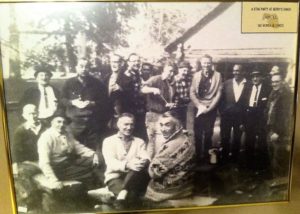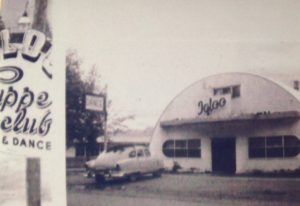Records indicate the Hope Rod & Gun Club was formed in 1946 by a dedicated group of conservationists, hunters, fishermen, and community-minded individuals. The original club, located in the Silver Creek area of Hope, held a number of informal shooting activities while promoting fish and game conservation in the district throughout the 1950’s. As well as excellent hunting, Hope’s close proximity to lakes and two major rivers spurred a surge in sport fishing and increased stewardship of our waterways.
In these early years, the club was very involved in the government’s plans to increase fishing production of streams and lakes and hosted the 1950 Fall Fish Convention, attended by delegates from all over BC. As well, in 1952 Major Tom Brayshaw gave a talk to Chilliwack sportsmen on designing and building split cane fishing rods, while Mr. Aubrie Woods shared his knowledge of fly tying; both gentlemen were considered experts in their rod and fly designs. The club regularly invited guest speakers to the meetings to share knowledge, presented informative documentaries, put forward resolutions to the BC Fish and Game Protective Association and sponsored popular fishing derbies, offering a substantial winning prize of $100.
Trapshooting was first introduced in 1952 and held at Tom Berry’s Ranch, a popular venue which is now under guardianship of the Nature Trust and BCIT Rivers Institute (since 2007). In 1954, due to growing interest, a Rifle and Revolver Club formed with plans to use a shooting range on Henry Johnson’s property at Haig. While it appears this Rifle club was a separate entity from the already established Hope Rod & Gun Club it is assumed that since both clubs shared the same goals they merged shortly after.
The first official recorded minutes of the club occurred in September of 1964 with 159 members, noting that all previous minutes were destroyed by fire. The details of the fire are unknown, but later that year the club decided to move the range and clubhouse from the Silver Creek location due to growing concerns from residents about noise. Hope’s Royal Canadian Legion hosted the club’s 22 shoot every Monday night in their basement, but by 1965 the Legion closed for renovation, forcing the club to look for a more permanent location.
In early 1965 Hope Rod & Gun Club members teamed up with members from the Yale Rod and Gun Club to form a committee to search for a new location. The Giant Mascot Mines Ltd. (nickel and copper) offered the club a generous lease agreement for a piece of land along the Trans-Canada Highway, just north of Hope, which became the permanent home to the Hope Rod & Gun Club—and still is today.
While the Yale members preferred to remain a separate club on their own, the Hope members proceeded with drawing up the lease and began working on the site in earnest. In 1968, the club purchased three ‘bunkhouses’ from G&T Logging and moved them to the new location; these buildings became the temporary indoor range, and official clubhouse.
Throughout the late 1960’s and early 1970’s, club members and community volunteers worked together to clear the land, erect fences, and retrofit the clubhouse. With dues set at $6/year in 1969, to help offset costs, the club sold cords of wood cut from the new property at $10/cord. The club also regularly held banquet dinners and dances at the local Igloo dance hall; these were very popular and well attended by all.
The club remained very active in environmental issues and supported community awareness. In 1968 it implemented a bursary program for Hope high school students. Club members also installed railings and signs at Sucker’s Creek, and sent formal support to the Government to designate Jones Lake as a provincial park.
In March of 1970, target shooting for women was introduced as well as a women’s trap night. The first official Rod & Gun Club meeting was held in the newly renovated clubhouse on December 5th, 1972 with 47 members in attendance. In 1979, the club purchased the land they were leasing from Giant Mascot Mines Ltd. which allowed the club to obtain permanent zoning, signage, and build an established presence in the Hope area, while offering a wider variety of range and fishing activities.
To date, the club continues to be very active in promoting preservation and instilling appreciation of nature. What is clear of Hope Rod & Gun Club’s illustrious 70-year history is the overwhelming dedication and hard work of volunteers who are passionate about conservation and responsible stewardship of the environment.
-
Recent News
Event Schedule
April 2024
Sun Mon Tue Wed Thu Fri Sat 123-
PISTOL SHOOT
PISTOL SHOOT
April 3, 2024 @ 6:00 PM - 8:00 PM
4567-
SILHOUETTE SHOOT
SILHOUETTE SHOOT
April 7, 2024
25905 Trans-Canada Hwy, Hope, BC V0X 1L3, CanadaTIMES: 9:00 AM - 12:00 PM
RANGE CLOSED ONE HOUR PRIOR AND ONE HOUR AFTER SHOOT FOR SETUP AND CLEAN UP.
89-
Regular Meeting - AGM
Regular Meeting - AGM
April 9, 2024
25905 Trans-Canada Highway, Hope, BC, Canada
10-
PISTOL SHOOT
PISTOL SHOOT
April 10, 2024 @ 6:00 PM - 8:00 PM
111213-
COWBOY SHOOT
COWBOY SHOOT
April 13, 2024
14-
TRAP SHOOT
TRAP SHOOT
April 14, 2024
25905 Trans-Canada Highway, Hope, BC, CanadaTIMES: 9:00 AM - 12:00 PM
RANGE CLOSED ONE HOUR PRIOR AND ONE HOUR AFTER SHOOT FOR SETUP AND CLEAN UP.
15-
RCMP RENTAL - RANGE CLOSED
RCMP RENTAL - RANGE CLOSED
April 15, 2024
1617-
PISTOL SHOOT
PISTOL SHOOT
April 17, 2024 @ 6:00 PM - 8:00 PM
18192021222324-
PISTOL SHOOT
PISTOL SHOOT
April 24, 2024 @ 6:00 PM - 8:00 PM
252627-
STEEL CHALLENGE SHOOT
STEEL CHALLENGE SHOOT
April 27, 2024
28-
TRAP SHOOT
TRAP SHOOT
April 28, 2024
25905 Trans-Canada Highway, Hope, BC, CanadaTIMES: 9:00 AM - 12:00 PM
RANGE CLOSED ONE HOUR PRIOR AND ONE HOUR AFTER SHOOT FOR SETUP AND CLEAN UP.
2930-
PISTOL SHOOT
Range Weather



